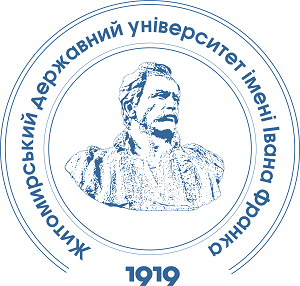ANTHROPOGENIC TRANSFORMATION OF DERIVED FORESTS OF THE ROBINIETEA CLASS ON THE TERRITORY OF THE UKRAINIAN POLISSIA
DOI:
https://doi.org/10.32782/naturaljournal.11.2025.33Keywords:
hemerobia, phytocenoses, environmental factors, invasive speciesAbstract
The article is devoted to studying the level of anthropogenic transformation of primary forestsof Ukrainian Polissia. The purpose of the study is to determine the level of anthropogenic transformation of different types of derived forests in the territory of Ukrainian Polissia, the relationship of environmental factors with it, and its impact on natural dynamics. In accordance with the goal,the following tasks were set: to classify derived forests according to the principles of the Brown-Blanke school; To determine the level of anthropogenic transformation of derived forest ecosystems; To investigate the relationship of anthropogenic transformation of derived forest ecosystems with leading environmental factors; To establish the impact of anthropogenic transformation on indicators of natural ecosystem dynamics; To determine the basic rules for correcting natural self-renewal of forest vegetation at the stage of primary forests. As a result of the study, it was established that the phytocenotic diversity of derived forests of the Robinietea class includes 2 orders, 5 unions, and 8 associations. Derived forests of the Robinietea class occupy stenotopic ecotopes according to all edaphic factors except the amount of available nitrogen and eurytopic according to anthropogenic transformationand the indicator of natural dynamics. The level of anthropogenic transformation of derived forestsof the Robinietea class ranges from 10.17 to 5.87 points with an average value of 7.88 points, which according to the Blume-Sukopp classification corresponds to the interval between oligohemerobiaand euhemerobia. Most derivatives with vegetation of this class are in the mesohemerobia zone. There is an inverse linear relationship between the indicators of anthropogenic transformation and natural dynamics with a correlation coefficient of 0.64. The position of ecosystems with Robinietea vegetation in the edapho-dynamic model is distinguished by the prospects for further successional development. Invasive edificator species will transform ecosystems into a state of catastrophic climax. Native species on flat areas of moderately rich soils will lead the ecosystem to energy climax by the shortest route.
References
Гарбар О.В., Весельська Е.В., Хом’як І.В., Гарбар Д.А. Просторово-часові зміни структури земельного покриву Словечансько-Овруцького кряжу. Український журнал природничих наук. 2024. № 7. С. 197–209. https://doi.org/10.32782/naturaljournal.7.2024.22.
Дідух Я.П., Плюта П.Г. Фітоіндикація екологічних факторів. Київ : Наукова думка, 1994. 280 с.
Дубина Д.В. Продромус рослинності України. Київ : Наукова думка, 2019. 784 с.
Хом’як І.В. Аналіз теорій поліклімаксу та моноклімаксу із позиції сучасної теорії динаміки екосистем. Екологічні науки. 2024. № 1 (52). С. 179–183. https://doi.org/10.32846/2306-9716/2024. eco.1-52.2.33.
Хом’як І.В. Характеристика асоціацій Agrostio-Populetum tremulae та Epilobio-Salicetum capreae класу Epilobietea angustifolii для Правобережного Полісся. Український ботанічний журнал. 2016. № 4. С. 239–254. http://dx.doi.org/10.15407/ukrbotj73.03.239.
Хом’як І.В., Овдіюк О.М. Контрольоване самовідновлення рослинності як альтернатива лісової рекультивації. Екологічні науки. 2024. № 4 (55). С. 229–233. https://doi.org/10.32846/2306-9716/2024.eco.4-55.37.
Якубенко Б.Є., Попович С.Ю., Устименко П.М., Дубина Д.В., Чурілов А.М. Геоботаніка: методичні аспекти досліджень. Ліра, 2020, 316 с.
Harbar O., Khomiak I., Kotsiuba I., Demchuk N., Onyshchuk I. Anthropogenic and natural dynamics of landscape ecosystems of the Slovechansko-Ovruchsky ridge (Ukraine). Soc. ekol. 2021. № 3. P. 347–367. https://doi.org/10.17234/SocEkol.30.3.1.
Hennekens S. Turboveg for Windows. 1998–2007. Version 2. Wageningen: Inst. voor Bos en Natuur, 2009. 84 p.
Janyszek S. Fitocenozy Agrostio-Populetum tremulae Pass. in Pass. et Hoffman 1968 puszczy bukowej kolo Szczecina. Roczniki Akademii Rolniczej w Poznaniu. Poznań: Wydawnictwo Akademii Rolniczej im. Augusta Cieszkowskiego w Poznaniu. 2003. Р. 51–57.
Khomiak I., Harbar O., Demchuk N., Kotsiuba І., Onyshchuk І. Above-graund phytomas dynam--ics in autogenic succession of an ecosystem. Forestry ideas. 2019. № 1. Р. 136–146.
Khomiak I.V., Bren A.L., Medvid O.V., Khomiak A.К., Maksymenko I.Yu. Dynamics of terrestrial vegetation on the territory of quarries as a model of post-military restoration of wild nature. Ukrainian Journal of Natural Sciences. 2023. № 5. P. 61–69. https://doi.org/10.32782/naturaljournal.5.2023.7.
Khomiak I., Harbar O., Kostiuk V., Demchuk N., Vasylenko O. Synphytoindication models of the anthropogenic transformation of ecosystems. Natura Croatica: Periodicum Musei Historiae Naturalis Croatici. 2024. № 33 (1). Р. 65–77. https://doi.org/10.20302/NC.2024.1.5.
Matuszkiewcz W. Przewodnik do oznaczania zbiorowisk roslinnych Polski. Warszawa : PWN. 2001. 536 p.
Młynkowiak E., Kutyna I. Zbirowisko z Betula pendula i Populus tremula w zadrzewieniach śryd-polnych Zachoniej Części pojezierza drawskiego. Folia Pomeranae univesitatis technologiae stetinen-sis. 2009. № 271 (10). Р. 113–126.
Westhoff V., Maarel E. van der. The Braun-Blanquet approach. Handbook of Vegetation Science. Part V: Ordination and Classification of Vegetation. Ed. By R.H.Whittaker. The Hague, 1973. P. 619–726.






